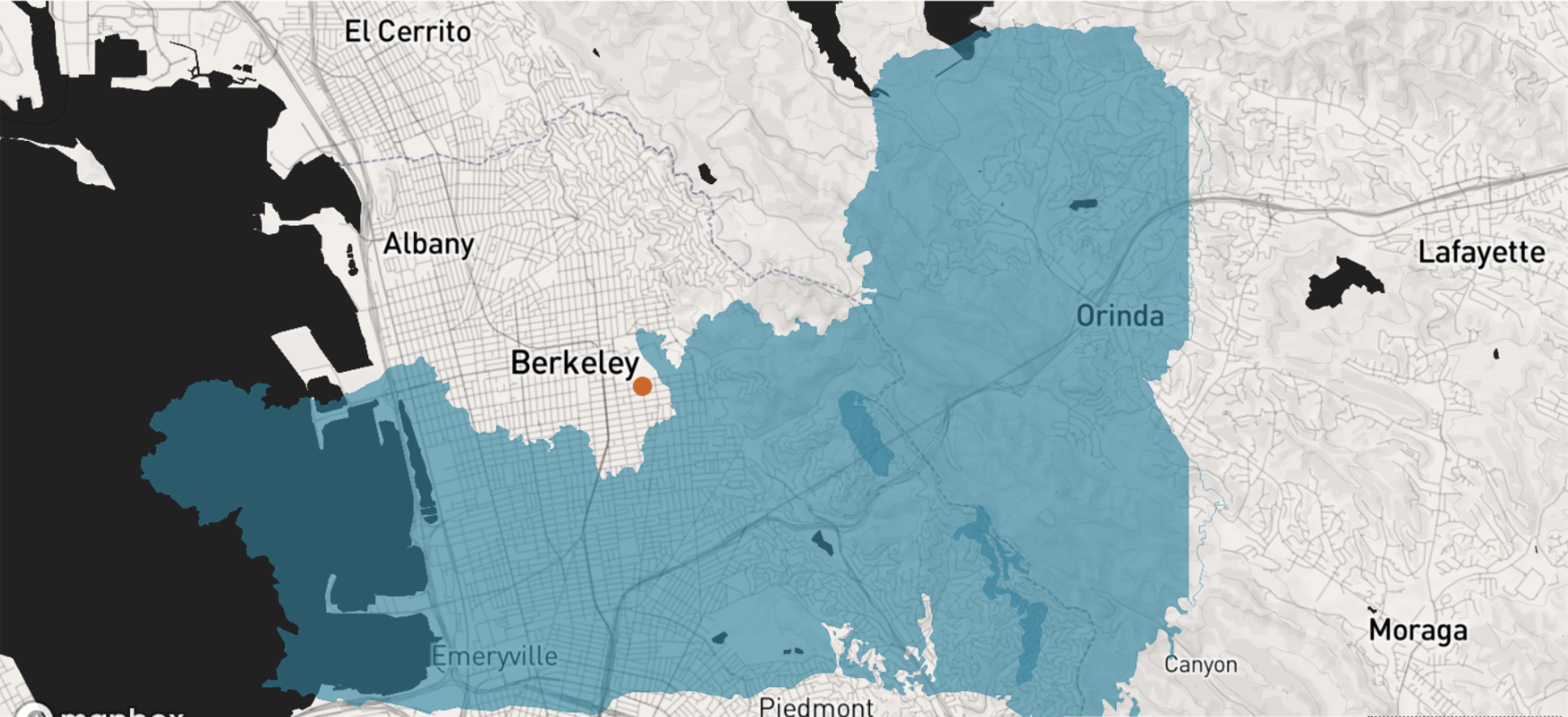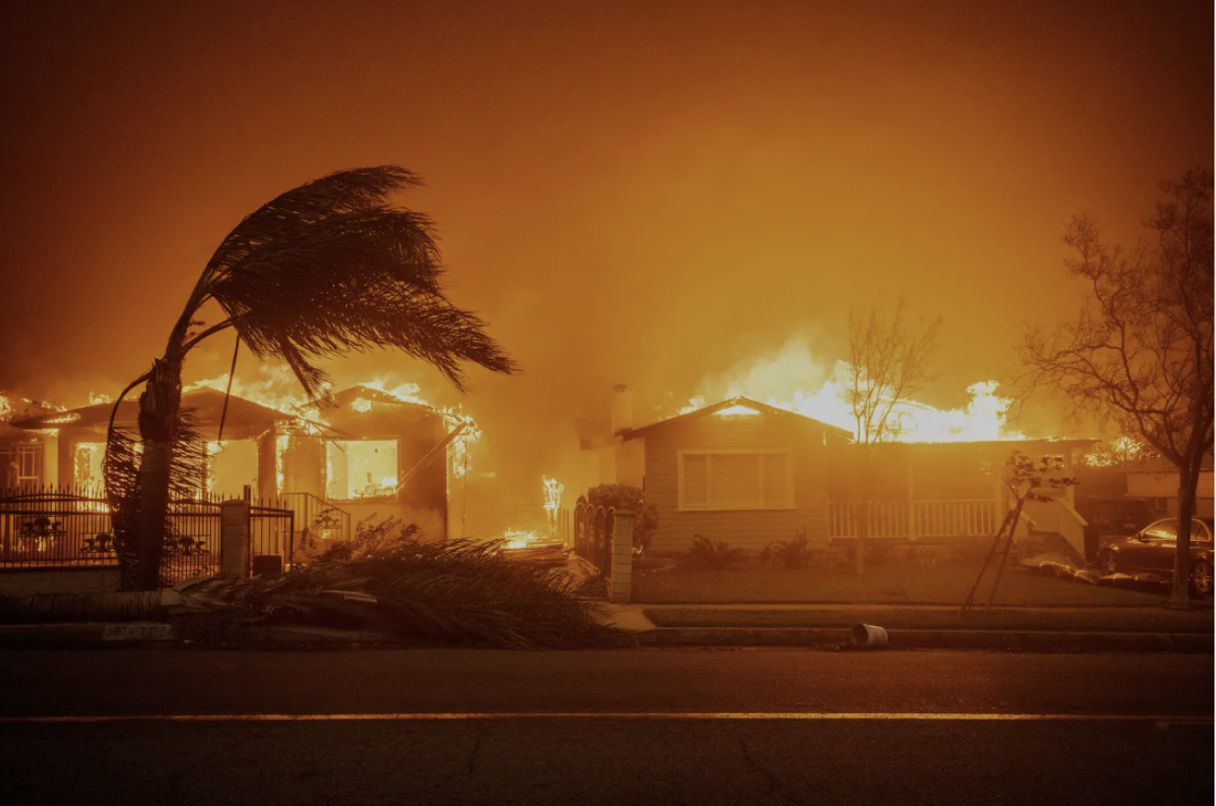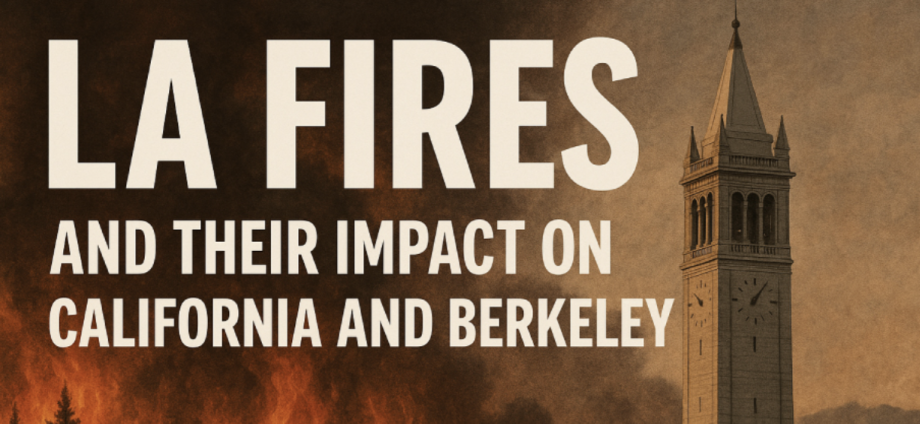Author: Colin Wong, Graphics: Nathan Nyaung
The 2025 LA wildfires worsened insurance, housing, and the wealth gap all over California. Learn how Berkeley — among its students, policies, and city prevention efforts — aimed to aid recovery.
In January of 2025, wildfires swept through Los Angeles County, leaving a devastating mark, consuming over 40,000 acres, destroying thousands of homes, and taking dozens of lives. The fires served as a stark reminder of California’s ongoing battle with climate-driven disasters, with repercussions felt far beyond LA. Hundreds of miles away, the fires sparked concerns over rising insurance costs, labor shortages in construction, and increased financial strain on students and homeowners. The Palisades Fire, which only accounted for half of the burned area in LA, is a clear example of the size of these fires. The Palisades Fire could have burned enough land to completely destroy Berkeley, including the entirety of the UC campus, the fire trails, and even parts of Oakland and Emeryville.

The Ripple Effect of LA’s Fires on Berkeley
Insurance and Homeownership Challenges
The wildfires further worsened California’s precarious home insurance market. As insurers grappled with billions of dollars in claims, they raised premiums or withdrew from the state altogether. Although the government introduced policies to stabilize insurance rates, consumer advocates warned that allowing insurers to set their rates based on future climate risks could lead to unaffordable hikes for homeowners. Adding on to concerns, California’s last-resort insurance plan, the FAIR Plan, was risky in terms of financial strains. If the FAIR Plan had become insolvent, policyholders across the state (including in Berkeley) would have lost access to practical insurance plans.

Beyond insurance, the fires distupted Berkeley’s housing and construction industries. With tens of thousands of structures destroyed in LA, labor shortages and material costs were expected to surge as construction workers were redirected to Southern California for work, and alongside skyrocketing demand for fast reconstruction of buildings and homes. Some sources predicted that construction costs could rise by 15-30%, based on information from previous natural disasters. This surge risks making it even more difficult for students and young professionals to find affordable housing, and potentially risks causing an increase in the unhoused population.
Impact on the Wealth Gap
In general, wildfires don’t just destroy cities, they also worsen existing economic inequalities. The financial burden of wildfires does not fall evenly across income groups. Wealthier homeowners often have the ability to rebuild their homes with private funds, while low and middle-income families, many of whom already struggle with homeownership disparities, face insurmountable barriers. In historically black communities, like Altadena, where homeownership is a critical foundation for building generational wealth, the rising costs of rebuilding and the pressure from predatory developers threaten to displace individuals and erase their generational wealth. Without targeted recovery support programs, marginalized communities will continue to be disproportionately affected by each wildfire season, which disrupts their recovery efforts.
This economic imbalance extends to Berkeley, where students from low-income backgrounds already contend with high rents and limited housing options. Many students have families from LA, who lost homes or were significantly impacted financially by the 2025 LA Wildfires. These students are now struggling to afford alternative housing, exacerbating their financial stress and affecting their ability to continue or succeed in their education.
The Fires’ Impact on Berkeley Students
For UC Berkeley students affected by the LA fires, the impact was both immediate and long-term. Survivors like Jolie Feld, who lost her family home in the Palisades Fire, faced the emotional toll of displacement while navigating an increasingly difficult housing market. Though her family’s home is still standing, they were not able to return for months due to extensive damage, leaving them struggling to find temporary housing amid soaring rental prices, where temporary accommodations have doubled in price. While attending Berkeley has helped Jolie — and other students — cope with her struggles as she looks to friends and extracurriculars for distraction, she still anticipates challenges in staying motivated as she processes the loss of her hometown.
In order to support its affected students and community, the university has implemented support systems, including increased financial aid, mental health resources, and academic accommodations for students struggling to balance recovery with coursework. Meanwhile, student-led initiatives, from grassroots fundraisers to microfunds, have demonstrated the resilience and solidarity of the Berkeley community in times of crisis.
What Berkeley is Doing About It
After witnessing the life-threatening consequences of wildfires, Berkeley has implemented changes to support its city infrastructure and community. In response to the growing wildfire threat, Berkeley pushed forward the EMBER initiative to bolster wildfire prevention. This plan includes designating new high-risk fire zones, enforcing “Zone 0” regulations that eliminate combustible materials around buildings, and providing incentives for fire-resistant home upgrades. The measures aim to reduce the risk of catastrophic fires in vulnerable areas like the Berkeley Hills.

Similarly, at the state level, CA policymakers are working to cap insurance rate hikes and ensure that recovery programs prioritize diverse, local businesses instead of large out-of-state firms. However, advocates argue that more must be done to prevent history from repeating itself, as seen in post-Katrina New Orleans, where low-income communities were largely excluded from rebuilding contracts. These plans are being implemented to protect communities, land, and our financials from the impacts that future wildfires might have. However, for these plans to succeed, they must prioritize supporting those who have lost the most in wildfires, instead of those who already have the means to support themselves.
Conclusion
Once again, the devastating LA wildfires served as a grim warning for Berkeley and the rest of California. Rising insurance costs, housing instability, and widening economic inequalities are not just problems for LA — but impact communities statewide. While Berkeley continues to take steps towards preparing for future wildfires, systemic changes are needed to ensure that recovery efforts are equitable and that all communities, regardless of income, can rebuild and thrive again. As climate disasters grow more frequent, proactive policies, financial safeguards, and community-driven solutions will be critical in preventing future devastation.
Take-Home Points
- The LA wildfires devastated over 40,000 acres, destroying thousands of homes and businesses, with effects reaching beyond Los Angeles.
- If the fires had occurred in Berkeley, they would have severely impacted nearly 4x the size of the city — including campus, fire trails, and surrounding neighborhoods.
- Rising premiums and reduced coverage options make it harder for homeowners, including small homeowners and lessors in Berkeley, to secure insurance.
- The fires increased labor and material shortages, delaying building projects and worsening California’s housing crisis.
- Impacts on insurance and labor costs in California as a whole result in low-income and minority communities facing disproportionate barriers to rebuilding, risking generational wealth loss.
- UC Berkeley students and faculty displaced by the fires continue to struggle with housing, financial, and emotional challenges.
- New wildfire prevention rules, insurance regulations, and university support aim to mitigate future disaster impacts.


Oh, the LA fires are really showing us how interconnected our problems are, arent they? Its fascinating to see how a disaster thousands of miles away could suddenly make Berkeley students question their ability to afford both rent *and* their sense of stability. The sheer scale of the destruction is impressive, though maybe slightly too much for a weekend getaway vibe. It’s heartwarming to see UC Berkeley rolling out the red carpet – free therapy sessions and maybe discounted housing units next? We’re all just waiting for the state to finally crack down on those pesky wildfires, maybe implement some basic fire prevention like… not setting things on fire? But seriously, the impact on low-income students and communities hit hardest is tough to read. Glad to see some proactive measures are in the works, though I suppose we should all start practicing our survive the apocalypse while paying rent skills.